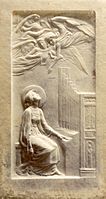Ellen Mary Rope facts for kids
Quick facts for kids
Ellen Mary Rope
|
|
|---|---|

Pencil portrait of the sculptor in her old age, by Rosamond Praeger
|
|
| Born | 14 March 1855 Blaxhall, England
|
| Died | 13 September 1934 (aged 79) Blaxhall, England
|
| Alma mater | Slade School of Fine Art |
| Known for | Sculpture |
|
Notable work
|
Bas-reliefs in metal and plaster; also decorative ceramics |
Ellen Mary Rope (1855–1934) was a talented British sculptor. A sculptor is an artist who creates figures or designs in 3D. She worked from 1885 until the early 1930s. Ellen was known for her many styles, from classic to popular. She mostly made 'bas-reliefs'. These are sculptures that stick out slightly from a flat surface. She used materials like stone, metal, or plaster.
Contents
Ellen Mary Rope's Early Life and Art Training
Ellen Mary Rope was born in Blaxhall, Suffolk, England. She was the seventh child of George and Anne Rope. People say she loved art from a young age. Her older brother, George Thomas Rope, was a landscape painter. He might have inspired her artistic journey.
To help her art skills grow, Ellen went to London in 1870. She studied at Nottingham Place School. There, she learned drawing from Octavia Hill, a famous social reformer.
Studying Art in England
Later, Ellen returned to her home village. She attended the Ipswich School of Art. One of her teachers was William T. Griffiths. Her first artworks were paintings and drawings. They showed rural scenes, much like her brother's art. They even exhibited their work together.
In 1877, she went back to London. She joined the Slade School of Fine Art. She continued to study drawing and painting. But in 1880, something changed her path. Professor Alphonse Legros started a new course. It was all about sculpture and modelling. Ellen joined this class. It greatly changed the direction of her art career.
Her Artistic Style and Home
Ellen's art followed the Arts and Crafts movement. This style focused on artists being involved in every step. It also preferred handmade items over machine-made ones. Ellen lived in London for most of her career. She shared a studio and home in Putney with her niece, Dorothy Anne Aldrich Rope. Dorothy was also her assistant.
Another niece, M. E. Aldrich Rope, had a stained-glass studio on the same road. It's important not to confuse her with a third artistic niece, Margaret Agnes Rope. Ellen Mary Rope retired to her family home in Blaxhall. This was shortly before she passed away in 1934 at age 79.
Ellen Mary Rope's Famous Sculptures and Projects
Ellen's first sculpture shown at the Royal Academy of Arts was in 1885. It was a terracotta panel called "David playing before Saul". After that, her work was shown at the Royal Academy almost every year until 1918. By 1893, she was well-known. She was asked to create four plaster relief figures for a big event.
Art for the World's Fair
These figures were for the Woman's Building (Chicago). This building was part of the World Columbian Exposition in Chicago. Each colorful panel was nearly six feet tall. They represented important ideas: Faith, Hope, Charity, and Heavenly Wisdom.
Art for Homes and Public Buildings
Besides her exhibition pieces, Ellen also made art for everyday people. She became a top designer for the Della Robbia Pottery. This was from 1896 until the pottery closed in 1906. This work led her to create popular pieces. They often featured children, flowers, and the sea. These small panels were made to be affordable. This way, more people could enjoy art.
Ellen also continued to get big projects for buildings. She made large figures for Morley Town Hall in Leeds. These figures of Faith, Hope, and Charity are now lost. She also created a 20-foot-long panel for Rotherhithe Town Hall. Sadly, this was destroyed during wartime bombing. She also made a memorial in cement at St Mary's, Bolton-on-Swale.
Connections and Other Works
Ellen had strong connections with the Garrett family. These friendships started in her childhood. Because of these ties, her Chicago panels were placed in a dining room. This was at the Chenies Street Ladies' Residential Chambers. This project was by her cousins, Rhoda Garrett and Agnes Garrett. Later, she made a marble memorial. It honored the mother of Elizabeth Garrett Anderson in Aldeburgh parish church.
Earlier, in 1894, Octavia Hill asked Ellen to create bas-reliefs. These were for the drawing room of the Women's University Settlement. This was in Nelson Square, Blackfriars. In 1902, Ellen created a marble memorial plaque. It honored Mary Anne Moberley. You can find this plaque in Salisbury Cathedral.
Gallery






